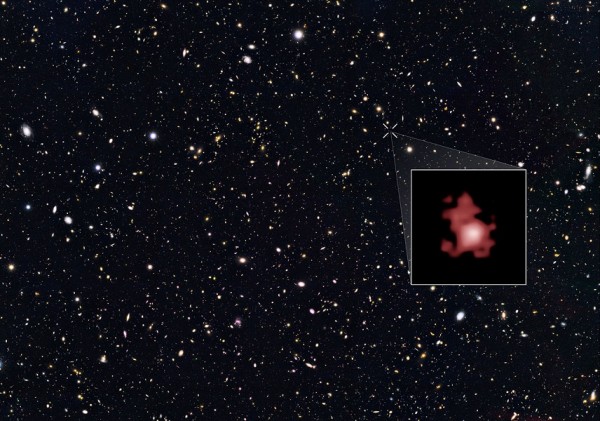By Ana Verayo, | March 05, 2016

This image shows the position of the most distant galaxy discovered so far within a deep sky Hubble Space Telescope survey called GOODS North (Great Observatories Origins Deep Survey North).
The most distant galaxy ever detected was revealed by the Hubble Space Telescope, providing scientists new insight about the evolution of the universe.
This extremely distant galaxy known as GN-z11, apparently existed just 400 million years after the Big Bang event, which is estimated to be 13.4 billion years old. Now, astronomers are viewing this galaxy during its original state some 13 billion years ago, since the light travelled that amount of time across the edges of the universe to reach Earth.
Like Us on Facebook
According to astronomer and lead author of the study, Pascal Oesch from Yale University, Hubble stepped back into time, during a time that this galaxy was existing when the universe was just three percent of its current age.
For astronomers to determine the age of GN-z11, scientists measured the light from the galaxy as it shifted by the universe's expansion which is called redshift. The higher the redshift, the more distant an object is from Earth. Prior to this galaxy, the highest redshift ever detected was from a galaxy known as EGSY8p7 whose redshift measured 8.68. However, GN-z11 possessed an even greater redshift at 11.1.
Since GN-z11 existed some 400 million years after the Big Bang, it only means that it belongs to the first generation of stars in the entire universe, when stars and galaxies were only beginning to form. According to co-author of the study, Rychard Bouwens of the University of Leiden in the Netherlands, the past record holders was observed in the middle of a time when starlight from the first infant galaxies were starting to heat up and lift this fog of cold, hydrogen gas enshrouding the cosmos.
This epoch is also known as a transitional period where re-ionization occurred among gases. This would also mean that GN-z11 is observed at 150 million years earlier, during the start of this crucial transition during the evolution of the universe.
To date, GN-z11 is also 25 times smaller than the Milky Way galaxy, possessing only one percent of the entire stellar mass of Milky Way. According to co-author of the study, Garth Illingworth from the University of California, Santa Cruz, it is truly amazing to view a galaxy that existed some 200 to 300 million years after the birth of the very first stars in the universe. This extremely rapid stellar growth, forming a galaxy with a billion solar masses happened so soon at this stage of the universe, he adds.
Researchers also revealed that GNz11 has been forming stars 20 times faster than the Milky Way, which is also the reason why it was so bright that this distant galaxy has been detected by the Hubble and Spitzer Space Telescope.
According to co-author of the study, Ivo Labbe from the University of Leiden, the discovery of this very ancient, primordial galaxy is telling us that current knowledge about the early universe is still very limited. The creation of GN-z11 is still a mystery for now, which can also possibly be the first generations of stars that formed around black holes.
This new study will be published in The Astrophysical Journal.
-
Use of Coronavirus Pandemic Drones Raises Privacy Concerns: Drones Spread Fear, Local Officials Say

-
Coronavirus Hampers The Delivery Of Lockheed Martin F-35 Stealth Fighters For 2020

-
Instagram Speeds Up Plans to Add Account Memorialization Feature Due to COVID-19 Deaths

-
NASA: Perseverance Plans to Bring 'Mars Rock' to Earth in 2031

-
600 Dead And 3,000 In The Hospital as Iranians Believed Drinking High-Concentrations of Alcohol Can Cure The Coronavirus

-
600 Dead And 3,000 In The Hospital as Iranians Believed Drinking High-Concentrations of Alcohol Can Cure The Coronavirus

-
COVID-19: Doctors, Nurses Use Virtual Reality to Learn New Skills in Treating Coronavirus Patients







